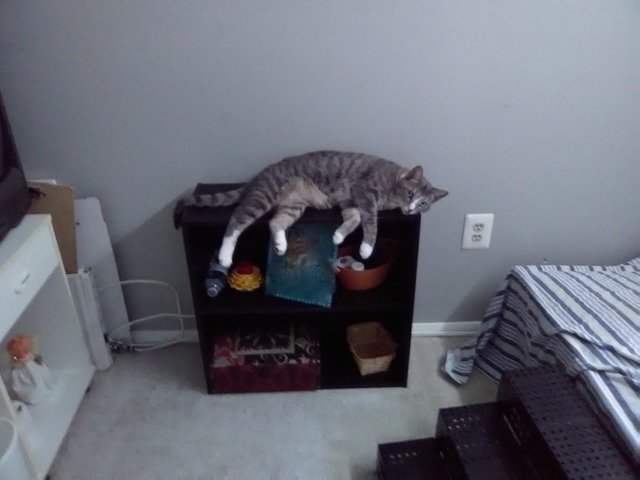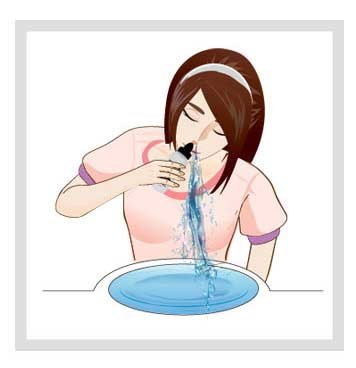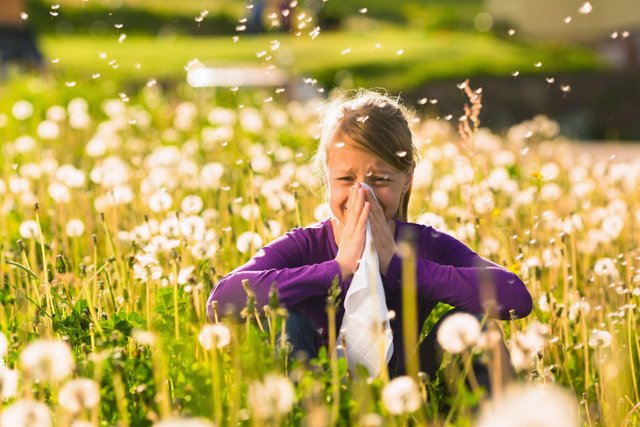Solutions for Allergy Sufferers
At the beginning of March most people start acknowledging out loud that allergy season is coming...get ready they say. Ahhhh... must be nice only having to worry about allergies symptoms 3 months out of the year. Unfortunately for those of us that are not just allergic to grasses and trees but also mold, dust, cats, and dogs our allergies are year round. I have some experience dealing with allergies and also have a medical background. Below are some tips that will help you get through your allergy symptoms regardless of what time of the year it is and give you some insight as to why you are always rubbing your eyes when Fluffy comes around.
 (As you can see by my cat in the picture above she pretty much lays where ever she wants, okay this is her room but she has the futon made up especially for her and her TWO beds in the room.)
(As you can see by my cat in the picture above she pretty much lays where ever she wants, okay this is her room but she has the futon made up especially for her and her TWO beds in the room.)
Symptoms of seasonal allergic rhinitis can occur in spring, summer and/or early fall (lucky you!). They are usually caused by allergic sensitivity to airborne mold spores or to pollen from grass, trees and weeds. Allergic rhinitis is also commonly known as hay fever. Some people have Perennial allergic rhinitis and they can experience symptoms year round. It is generally caused by dust mites, pet hair or dander, cockroaches or mold. Some people may experience both types of rhinitis, with perennial symptoms getting worse during specific pollen seasons. There are also nonallergic causes for rhinitis (but that is another article altogether).
Symptoms of allergic rhinitis include runny nose, itchy eyes, mouth or skin, sneezing,stuffy nose due to blockage or congestion which of course can lead to mouth breathing and my husband's favorite..snoring, loudly. It can also lead to fatigue which is often reported because of poor quality sleep as a result of nasal obstruction. Besides the usual suspects of pollen from grass, trees and weeds; pet hair or dander, dust mites and mold; Irritants, such as cigarette smoke, perfume and diesel exhaust can also trigger symptoms.
There are several ways to manage and treat your symptoms. Medication, behavior modifications, and sometimes Autoimmune Therapy can be very helpful. First avoid triggers by keeping windows closed during high pollen period and using air conditioning in your home and car. Remember to wear glasses or sunglasses when outdoors to keep pollen out of your eyes. Use “"allergy" bedding covers to limit exposure to dust mites and a dehumidifier to control mold. Change your filters frequently. Wash your hands after petting any animal and have a nonallergic person help with pet grooming, preferably in a well-ventilated area or outside. Vacuum, dust, and sweep your home regularly.
Nasal irrigation is also a good way to remove the allergens from your nasal canal. This process can also shorten colds when symptoms begin, I don't know if there is any scientific evidence but it works for me. This involves a solution that is specifically prepared and used in addition to a device like a pot or bottle and it is used to flush the nostrils. Some people say it feels like you are drowning, sometimes you get a weird taste in your mouth afterward. You will definitely be blowing your nose for about 15 minutes afterward but that is the point. There are several products you can use to irrigate your noise with just take a look at what is available at the store.
 image credit @yogawithsubbash.com
image credit @yogawithsubbash.com
You can control some symptoms with over-the-counter medication. Decongestants are nasal sprays or oral medication that usually need to be taken in conjunction with antihistamines (eye drops, nasal spray and oral medications). Long lasting medications like Ceterizine, Loratadine, and Fexofenadine to name a few work well but must be taken before allergy symptoms start to be the most effective. Diphenhydramine works well for acute symptoms and for quick results. I carry it with me EVERYWHERE!!
Allergy shots or AIT (Allergy Immunotherapy) are given at an allergist office. Your allergist or doctor injects small doses of substances that you are allergic to under your skin. This helps your body "get used to" the allergens, which can result in fewer or less severe symptoms of allergic rhinitis.

image credit @certifiedallergyesa.com
Your allergist may start by taking a detailed history, looking for clues in your lifestyle that will help pinpoint the cause of your symptoms. You’ll be asked, among other things, about your work and home environments (including whether you have a pet), your eating habits, your family’s medical history and the frequency and severity of your symptoms. Sometimes allergic rhinitis can be complicated by several medical conditions. Your allergist will probably recommend a skin test, in which small amounts of suspected allergens are introduced into your skin. Skin testing is the easiest, most sensitive and generally least expensive way of identifying allergens. Your allergy shots will be created from your test results. Allergy shots take a lot of commitment and is not for the faint of heart. Usually includes two shots a week for several weeks than once a month for several years. It can also be costly since some insurance plans do no cover it and vials must be remade frequently.
I hope that this article helped you and gave you some insight into the world of allergies, now if you will excuse me I have to irrigate my nose ;-)
